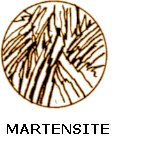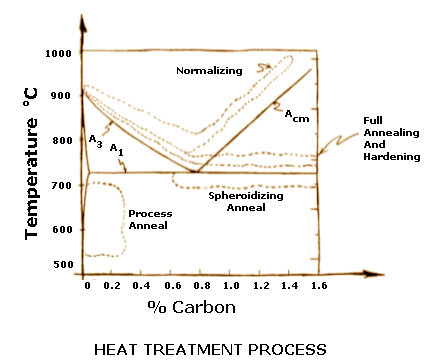Cryogenic Treatment
Cryogenics, or deep freezing is done to make sure there is no retained Austenite during quenching. When steel is at the hardening temperature, there is a solid solution of Carbon and Iron, known as Austenite. The amount of Martensite formed at quenching is a function of the lowest temperature encountered. At any given temperature of quenching there is a certain amount of Martensite and the balance is untransformed Austenite. This untransformed austenite is very brittle and can cause loss of strength or hardness, dimensional instability, or cracking.
 |
 |
Quenches are usually done to room temperature. Most medium carbon steels and low alloy steels undergo transformation to 100 % Martensite at room temperature. However, high carbon and high alloy steels have retained Austenite at room temperature. To eliminate retained Austenite, the temperature has to be lowered.
In Cryogenic treatment the material is subject to deep freeze temperatures of as low as -185°C (-301°F), but usually -75°C (-103°F) is sufficient. The Austenite is unstable at this temperature, and the whole structures becomes Martensite. This is the reason to use Cryogenic treatment.
Spring Aging
A wound spring can lose its spring tension due to anelastic behavior, which causes the spring to unwind or change its shape over time.
To avoid this springs are placed in an oven at 315 - 375 ºC (600 - 707 ºF) for 2 hours for spring aging. This will allow the spring to change shape or unwind. This unwinding or changing shape can be accommodated during the design of the spring and be compensated. Once the springs are treated to spring aging, they do not usually change shape.
Stress Relieving
Machining induces stresses in parts. The bigger and more complex the part, the more the stresses. These stresses can cause distortions in the part long term. If the parts are clamped in service, then cracking could occur. Also hole locations can change causing them to go out of tolerance. For these reasons, stress relieving is often necessary.
Typically, the parts that benefit from stress relieving are large and complex weldments, castings with a lot of machining, parts with tight dimensional tolerances and machined parts that have had a lot of stock removal performed.

Stress relieving is done by subjecting the parts to a temperature of about 75 ºC (165 ºF) below the transformation temperature,line A1 on the diagram, which is about 727 ºC (1340 ºF) of steel—thus stress relieving is done at about 650 ºC (1202 ºF) for about one hour or till the whole part reaches the temperature. This removes more than 90% of the internal stresses. Alloy steels are stress relieved at higher temperatures. After removing from the furnace, the parts are air cooled in still air.

